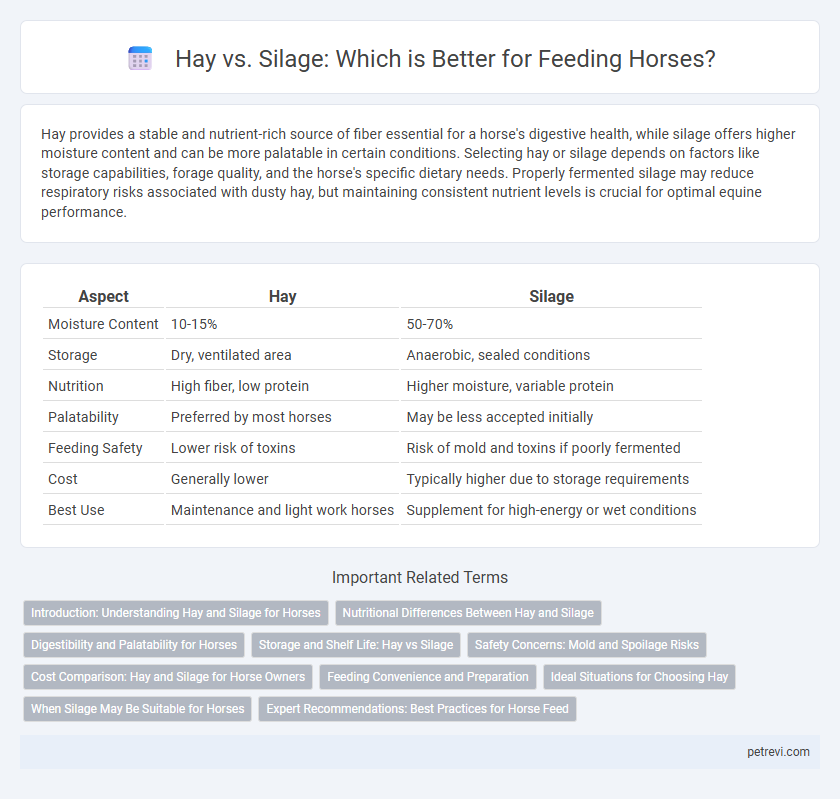Hay provides a stable and nutrient-rich source of fiber essential for a horse's digestive health, while silage offers higher moisture content and can be more palatable in certain conditions. Selecting hay or silage depends on factors like storage capabilities, forage quality, and the horse's specific dietary needs. Properly fermented silage may reduce respiratory risks associated with dusty hay, but maintaining consistent nutrient levels is crucial for optimal equine performance.
Table of Comparison
| Aspect | Hay | Silage |
|---|---|---|
| Moisture Content | 10-15% | 50-70% |
| Storage | Dry, ventilated area | Anaerobic, sealed conditions |
| Nutrition | High fiber, low protein | Higher moisture, variable protein |
| Palatability | Preferred by most horses | May be less accepted initially |
| Feeding Safety | Lower risk of toxins | Risk of mold and toxins if poorly fermented |
| Cost | Generally lower | Typically higher due to storage requirements |
| Best Use | Maintenance and light work horses | Supplement for high-energy or wet conditions |
Introduction: Understanding Hay and Silage for Horses
Hay and silage are two primary forage options for horse feed, each with distinct nutritional profiles and preservation methods. Hay is dried grass or legumes, offering high fiber and consistent nutrient content, ideal for maintaining digestive health in horses. Silage, fermented moist forage, provides higher moisture and energy levels but requires careful management to avoid spoilage and maintain palatability.
Nutritional Differences Between Hay and Silage
Hay contains higher fiber and lower moisture content compared to silage, promoting better gut motility and reducing the risk of digestive upset in horses. Silage, with its higher moisture levels and fermentation process, offers increased energy density and improved palatability but may have variable nutrient profiles depending on fermentation quality. Understanding these nutritional differences helps optimize equine health by selecting the appropriate forage type for specific energy and fiber requirements.
Digestibility and Palatability for Horses
Hay offers higher digestibility due to its lower moisture content, allowing horses to efficiently absorb nutrients and maintain gut health. Silage, with its higher moisture and fermentation process, may enhance palatability but can vary in digestibility depending on fermentation quality and storage conditions. Choosing between hay and silage requires considering the horse's digestive capacity and preference to ensure optimal nutrient intake and feed acceptance.
Storage and Shelf Life: Hay vs Silage
Hay offers longer shelf life when stored in a dry, well-ventilated environment, maintaining nutritional quality for up to 12 months. Silage requires airtight, anaerobic storage conditions such as sealed plastic wraps or silos to prevent spoilage and typically remains usable for 6 to 12 months. Improper storage of either feed type can lead to mold growth, nutrient loss, and potential health risks for horses.
Safety Concerns: Mold and Spoilage Risks
Hay can pose safety concerns for horses due to the risk of mold contamination, which produces mycotoxins harmful to equine respiratory and digestive health. Silage, if improperly fermented or stored, may also lead to spoilage, increasing the risk of botulism and other bacterial infections in horses. Regular inspection and proper storage conditions are critical to minimizing these mold and spoilage risks in both hay and silage feed.
Cost Comparison: Hay and Silage for Horse Owners
Hay typically costs more per ton but requires less specialized storage than silage, which can lower initial investment expenses for horse owners. Silage offers higher moisture content, reducing wastage and potentially balancing out costs despite the need for airtight storage solutions like silage clamps or plastic wraps. Evaluating local market prices and storage capabilities helps horse owners determine the most cost-effective feeding option.
Feeding Convenience and Preparation
Hay requires minimal preparation and can be fed directly to horses, making it highly convenient for regular feeding routines. Silage, while offering higher moisture content, demands airtight storage and careful handling to prevent spoilage, adding complexity to feeding preparation. Choosing between hay and silage depends on the available storage facilities and the time invested in feed management.
Ideal Situations for Choosing Hay
Hay is ideal for horses requiring a high-fiber, low-moisture diet, especially in dry climates where moisture content can affect storage quality. Horses with dental issues or those prone to colic benefit from the fibrous texture of hay, which promotes chewing and digestion. Additionally, hay is preferred during stable feeding when consistent nutrient content and long-term storage without spoilage are critical.
When Silage May Be Suitable for Horses
Silage may be suitable for horses when high moisture forage is needed, especially in regions with limited access to quality hay or during wet seasons that prevent proper hay drying. It provides a palatable, nutrient-rich alternative that can support horses requiring higher energy intake or those with dental issues that make dry hay difficult to chew. Proper fermentation and storage techniques are crucial to ensure silage maintains its nutritional value and is safe for equine consumption.
Expert Recommendations: Best Practices for Horse Feed
Expert recommendations emphasize hay as the preferred horse feed due to its consistent nutrient content and lower risk of spoilage compared to silage. High-quality hay, such as timothy or orchard grass, provides essential fiber and supports digestive health, whereas silage requires careful fermentation control to prevent mold and mycotoxin risks. Proper storage and regular feed analysis are critical best practices to ensure safe, balanced nutrition tailored to the horse's age, workload, and health status.
Hay vs Silage for Horse Feed Infographic

 petrevi.com
petrevi.com